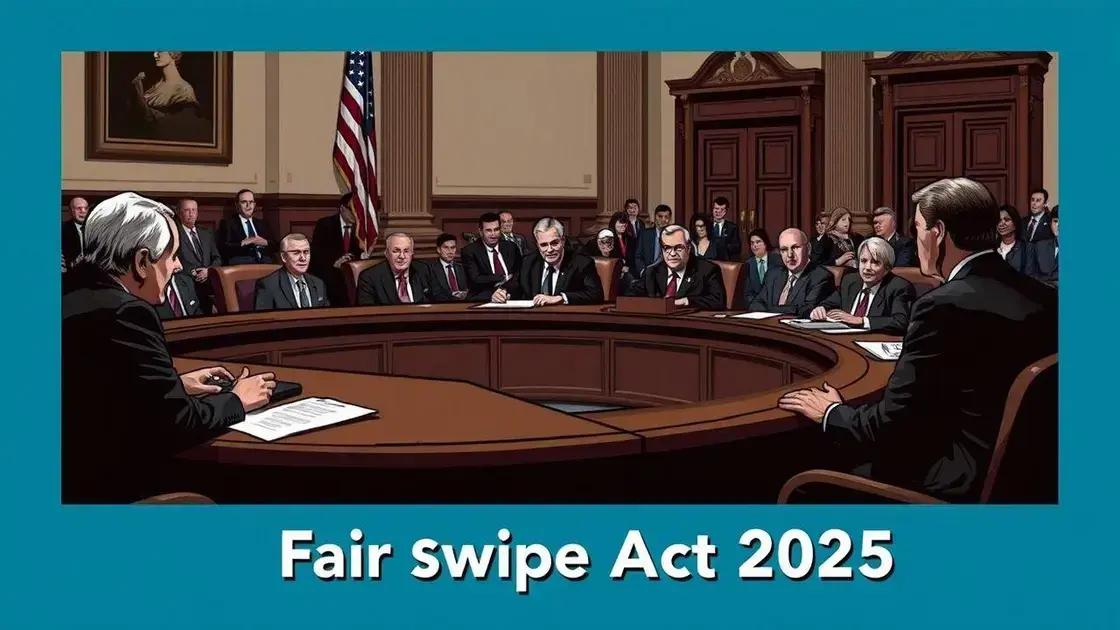Fair Swipe Act 2025 under congressional review: what’s at stake?

The Fair Swipe Act 2025 aims to enhance transparency in payment processing, reduce hidden fees for consumers, and support small businesses by enforcing fair practices across the industry.
Fair Swipe Act 2025 under congressional review has become a hot topic in recent discussions about consumer rights. What does it mean for you? Let’s dive into the details that could shape the future of commerce.
Overview of the Fair Swipe Act 2025
The Fair Swipe Act 2025 is a significant piece of legislation aimed at protecting consumers and ensuring fair trading practices in various industries. This act’s main goal is to address the growing concerns regarding unfair fees and deceptive practices that can harm both consumers and businesses.
Key Features of the Act
This act introduces key provisions designed to enhance transparency and consumer protection. One major focus is on limiting excessive fees that payment processing companies can impose on merchants. By doing this, the act aims to create a fairer marketplace.
- Enhanced transparency in fee structures.
- Protection against deceptive practices.
- Support for small businesses.
Another important aspect of the Fair Swipe Act 2025 is the establishment of a regulatory framework. This framework will oversee compliance, ensuring that all players in the payment processing space adhere to fair practices. With this oversight, consumers can feel more secure in their transactions.
Implications for Consumers
Consumers stand to benefit significantly from this act. By promoting fair practices, it aims to reduce the hidden fees that often catch shoppers by surprise. This will not only foster trust in the payment systems but also encourage more informed decision-making.
Additionally, the act empowers consumers by providing them with more options and clearer information about fees and services. This newfound clarity can lead to better choices and potentially lower costs when shopping.
The Fair Swipe Act 2025 also encourages competition among payment service providers. By leveling the playing field, it opens the door for innovative solutions that can benefit consumers and small businesses alike. The act’s aim is to encourage healthy competition that drives improvements in service and pricing.
Ultimately, as discussions unfold in Congress, the Fair Swipe Act could be a game-changer for everyone involved in the transaction process, reshaping how we view transactions in the digital age.
Key provisions and objectives of the act
The Fair Swipe Act 2025 introduces several key provisions aimed at enhancing consumer protection and ensuring fair practices in the payment processing industry. One objective of the act is to eliminate hidden fees that can burden both consumers and small businesses.
Transparency in Fee Structures
A major focus of the act is to require payment processors to provide clear breakdowns of their fee structures. By mandating transparency, the act empowers consumers to make informed decisions when choosing payment services. This means that businesses will need to clearly display all fees involved, allowing consumers to understand the costs upfront.
- Mandatory disclosure of fees.
- Clear explanations of each service cost.
- Enhanced consumer awareness.
Furthermore, the Fair Swipe Act 2025 aims to protect smaller businesses from unfair practices by larger companies. It does this by prohibiting monopolistic behaviors that can stifle competition. This protection is vital for creating a balanced marketplace where every business has a fair chance to succeed.
Support for Small Businesses
In addition to protecting consumers, the act prioritizes support for small businesses. It emphasizes the need for fair treatment and equitable access to payment processing services. By implementing these rules, the act seeks to create an environment where small businesses can thrive.
The Fair Swipe Act 2025 also includes provisions that encourage innovation in payment methods. By promoting new technologies, the act aims to improve the overall consumer experience. This innovation can lead to more efficient transactions and a broader range of payment options.
Ultimately, through these key provisions and objectives, the Fair Swipe Act 2025 aims to reshape the payment processing landscape, making it fairer and more transparent for all stakeholders involved.
Potential impacts on consumers and businesses

The Fair Swipe Act 2025 promises to have significant impacts on both consumers and businesses alike. By focusing on transparency and fairness, the act creates a better environment for financial transactions.
Benefits for Consumers
Consumers can expect greater protection from hidden fees. One of the main goals of the act is to ensure that payment processing fees are clearly outlined, making it easier for consumers to understand what they are paying for. This transparency builds trust and leads to more informed shopping choices.
- Reduced unexpected costs at checkout.
- Access to clearer information regarding fees.
- Empowered decision-making when selecting payment methods.
Moreover, consumers will benefit from a wider range of options as payment processors compete more openly. With the new regulations, customers can choose services that best fit their needs, leading to improved overall customer satisfaction.
Effects on Businesses
For businesses, especially small ones, the Fair Swipe Act 2025 seeks to level the playing field. Small businesses often struggle with high fees imposed by larger payment processors. By enforcing fair fee structures, the act helps these businesses keep more of their earnings.
Additionally, the act aims to promote competition among payment providers. Increased competition can drive down costs and encourage innovation. As payment options expand, businesses can select the services that suit their operational needs without facing monopolistic pressures.
Furthermore, the act will likely encourage businesses to adopt new technologies that enhance transaction processes. This adoption can lead to more efficient operations and better service for consumers.
Overall, as the Fair Swipe Act 2025 is implemented, both consumers and businesses can look forward to a fairer and more transparent payment landscape.
Current status and congressional discussions
The Fair Swipe Act 2025 is currently under active discussion in Congress. Lawmakers are engaging in debates about the provisions and impacts of the act. This ongoing dialogue is crucial as it addresses concerns from both consumers and businesses regarding payment processing practices.
Legislative Progress
As of now, the act has passed through initial committees and is headed for further hearings. These hearings allow legislators to gather input from various stakeholders, including consumer advocacy groups, small business owners, and payment processing companies. This broad range of perspectives is essential for creating well-rounded legislation.
- Testimonies from affected parties help shape the discussion.
- Key amendments are being proposed to refine the act.
- Lawmakers are focused on ensuring equitable practices for all.
In addition to this, there are proposals aimed at enhancing consumer protections against unfair practices. Legislators are considering ways to tighten regulations on fee disclosures and other key aspects of the act. These considerations highlight the importance of transparency in the payment processing industry for protecting consumers.
Challenges Ahead
Despite the progress, there are challenges ahead. Some lawmakers express concerns about the potential burden that new regulations could impose on businesses. They argue that excessive regulation might stifle innovation in the payment sector. Balancing consumer protection with the need for a competitive market remains a significant challenge.
As discussions continue, there may be more amendments to the Fair Swipe Act 2025. The goal is to ensure that it meets the needs of consumers while supporting businesses. Engaging various interests in the discussions is key to creating effective legislation.
Overall, staying updated on the current status of the act will be essential as it progresses through Congress. The outcomes of these discussions will shape the future of payment processing practices across the country.
How to engage with lawmakers about the act
Engaging with lawmakers about the Fair Swipe Act 2025 is essential for ensuring that consumer and business voices are heard. Understanding how to effectively communicate with representatives can lead to meaningful changes in the legislation.
Understanding the Process
To start, it is crucial to understand how the legislative process works. Knowing when lawmakers are discussing the act helps you reach out at the right time. Regularly check congressional calendars or visit official websites for updates on hearings and discussions.
- Follow key committees responsible for the act.
- Stay informed about public hearings.
- Know your representative’s stance on consumer rights.
Once you have this information, you can prepare your message. Clearly articulate your concerns or support for specific provisions of the Fair Swipe Act 2025. Personal stories about how hidden fees affect your daily life can have a strong impact on lawmakers.
Connecting with Lawmakers
There are various ways to connect with lawmakers. One effective method is to schedule a meeting. You can visit their offices in person to discuss your views. If meeting in person is not possible, consider virtual meetings or phone calls as alternatives.
Additionally, writing letters or emails is another way to engage them. Be sure to address your lawmakers directly and be concise. Include your name, address, and relevant speaking points about the act. Highlight how it impacts your community and why it matters.
Social media platforms also provide an avenue for engagement. Many lawmakers are active on social media, allowing you to share your thoughts and opinions publicly. Tagging them in posts or using relevant hashtags can increase visibility.
Finally, consider joining or supporting advocacy groups focused on consumer rights. These organizations often have established relationships with lawmakers and can amplify your voice. They can provide useful tools and resources to facilitate your engagement.
Overall, actively participating in discussions about the Fair Swipe Act 2025 is vital. Engaging with lawmakers not only raises awareness but can also influence the future of payment practices.
Fair Swipe Act 2025 is a crucial step towards ensuring fairness in the payment processing industry. By encouraging transparency and protecting consumers, this legislation has the potential to reshape how transactions occur. It opens doors for businesses, particularly small ones, allowing them to thrive in a competitive market. Engaging with lawmakers is essential, as each voice matters in this legislative process. By working together, consumers and businesses can influence the future of payment practices and build a fairer economy for everyone.
FAQ – Questions about the Fair Swipe Act 2025
What is the Fair Swipe Act 2025?
The Fair Swipe Act 2025 is legislation designed to promote transparency and fairness in payment processing, protecting consumers from hidden fees.
How does this act benefit small businesses?
This act levels the playing field by limiting excessive fees imposed by larger companies, allowing small businesses to retain more of their earnings.
How can I engage with lawmakers about the act?
You can reach out to your representatives through meetings, letters, emails, or social media to express your support or concerns regarding the act.
What are the potential impacts of the act on consumers?
Consumers will benefit from reduced hidden fees and increased transparency in payment processing, leading to better decision-making when shopping.






